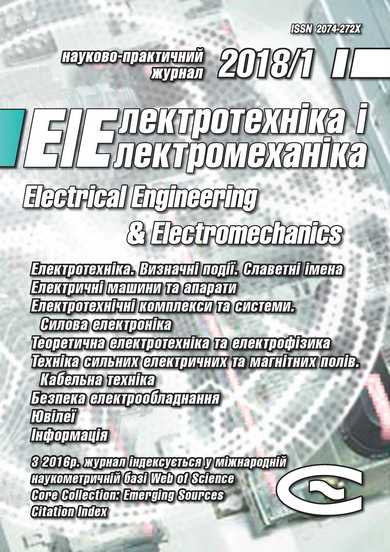ANALYSIS OF ELECTROMAGNETIC PROCESSES IN THE SYSTEM «CYLINDRICAL SOLENOID – MASSIVE CONDUCTOR»
DOI:
https://doi.org/10.20998/2074-272X.2018.1.08Keywords:
induction heating, Maxwell’s equations, sheet metal, electromagnetic field, electrodynamic problem, eddy currentsAbstract
Purpose. Defining the key parameters of the inductor geometry, as a long multi-turn solenoid, that influence on the current amplitude induced excited in a massive conductor with a flat boundary surface. Methodology. Performing a mathematical analysis of the electrodynamic problem solution for an area with variable structure by integrating Maxwell's equation within the given boundary and initial conditions and also physical assumptions simplifying the process of solving but not distorting the result and carrying out an experiment that confirms not only the correctly construction considered but also the acceptability of the chosen assumption the opacity applying of the metal blank for these operating fields frequencies. Results. Functional dependencies of the current induced parameters on the metal surface of the heating object have been obtained, along which numerical estimates of the electrodynamic process have been performed, and key parameters influencing the heating efficiency have been determined. The correctness of the solutions obtained was confirmed experimentally. The final form of the solution function of the physical-mathematical problem was shown to be acceptable for performing further engineering and research calculations. Originality. The functional connection of the measured values of the induced surface current and the parameters of the measuring system is determined, the experimental confirmation of which indicates the satisfactory calculation model of the induction heating system and the entire solution as a whole. Practical value. Based on the calculations performed, working samples of inductive systems for induction heating that meet the specified heating rate and area requirements can be constructed. The obtained analytical expressions were transformed and simplified for their further using for engineering calculations with a minimum error value.References
1. Batygin Yu.V., Gnatov A.V., Chaplygin Ye.O., Sabokar O.S. Sposib indukcijnogo nagrivu dlja remontu metalevyh elementiv avtomobil'nyh konstrukcij [Method of induction heating for repair of the metal automobile constructions elements]. Patent UA, no.103494, 2015. (Ukr).
2. Kennedy M.W. Magnetic fields and induced power in the induction heating of aluminium billets. Licentiate Thesis. Royal Institute of Technology, Stockholm, 2013.70 p.
3. Wright J. Principles of high frequency induction tube welding. Washington Electronic Heating Equipment Inc., 1997. 8 p.
4. Klonk S. Modélisation Numérique du Chauffage par Induction de Pièces à Géométrie Complexe. [Numerical modelling of induction heating for complex geometrical parts]. Thèse pour obtenir le grade de docteur délivré. Doctorat Paris Tech. Paris, 2013. 186 p. (French).
5. Korshikov S.E. Optimal'noye upravleniye temperaturnymi rezhimami induktsionnogo nagreva tsilindricheskikh slitkov s uchetom tekhnologicheskikh ogranicheniy. Diss. kand. techn. nauk [Optimum control of temperature modes of cylindrical ingots induction heating taking into account technological limitations. Cand. tech. sci. diss.]. Samara, 2015. 153 p. (Rus).
6. Dershpak N.S. The modes of induction heating of cylindrical parts connected with tension fitting. Technical electrodynamics, 2009, no.6, pp. 61-65. (Ukr).
7. Batygin Yu.V., Lavinskiy V.I., Khimenko L.T. Impul'snyye magnitnyye polya dlya progressivnykh tekhnologiy. Tom 1. Izdaniye vtoroye, pererabotannoye i dopolnennoye. [Pulsed magnetic fields for advanced technologies. Vol.1. 2nd edition, revised and enlarged.] Kharkov, MOST-Tornado Publ., 2003. 284 p. (Rus).
8. Shneerson G.A. Polya i perehodnye processy v apparature sverhsilnyh tokov [Fields and transients in equipment ultra strong currents]. Moscow, Energoatomizdat Publ., 1992, 413 p. (Rus).
Downloads
Published
How to Cite
Issue
Section
License
Copyright (c) 2018 Yu. V. Batygin, E. A. Chaplygin, O. S. Sabokar, V. A. Strelnikova

This work is licensed under a Creative Commons Attribution-NonCommercial 4.0 International License.
Authors who publish with this journal agree to the following terms:
1. Authors retain copyright and grant the journal right of first publication with the work simultaneously licensed under a Creative Commons Attribution License that allows others to share the work with an acknowledgement of the work's authorship and initial publication in this journal.
2. Authors are able to enter into separate, additional contractual arrangements for the non-exclusive distribution of the journal's published version of the work (e.g., post it to an institutional repository or publish it in a book), with an acknowledgement of its initial publication in this journal.
3. Authors are permitted and encouraged to post their work online (e.g., in institutional repositories or on their website) prior to and during the submission process, as it can lead to productive exchanges, as well as earlier and greater citation of published work.





